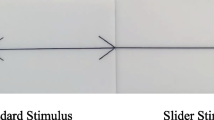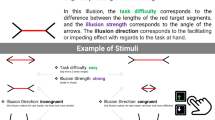Abstract
Objective
The Müller-Lyer illusion is a visual illusion in which a horizontal shaft with an inward-pointing chevron (fins-out) affixed to each end is perceived longer than a shaft with outward-pointing chevrons (fins-in). The goal of this study was to compare the effects of experience and knowledge about the Müller-Lyer illusion on participants’ perceptual precision.
Method
Participants were undergraduate students (n = 108) who were not familiar with the Müller-Lyer illusion prior to the experiment. The task of participants was to adjust one movable line to make it equal to the other in Müller-Lyer figure. They received ascending and descending Müller-Lyer trials in three blocks with 20 trials each. The Experimental Group received information about the Müller-Lyer illusion prior to the third block.
Results
For the Experimental Group, the amount of departure in Block 3 was reduced significantly compared with previous blocks.
Conclusion
Knowledge about the mechanisms underlying visual illusions may play an important role in helping individuals overcome them.
摘要
目的
缪勒一莱尔错觉(Müller-Lyer illusion)是一种视错觉, 即一条水平线段两端加上向外的箭头(fins-out), 那么它看起来要比带有向内箭头(fins-in)的线段长些。 本研究的目的是比较练习和有关知识对缪勒一莱尔错觉受试者感知精确度的不同影响。
方法
受试者为 事先对缪勒一莱尔错觉不了解的大学生(共108人, 其中对 照组20 人), 他们被要求在缪勒一莱尔模型中调整一条可移动线段的长度, 使其与另一条线段的长度相同。 受试者要接受缪勒一莱尔递增测试和递减测试。 测试共分三个阶段, 每阶段20 次(10 次递增测试, 10 次递减测试)。 在第三阶段测试开始前, 实验组学习了缪勒一莱尔错觉的有关知识。
结果
在实验组中, 第三阶段测试的偏差明显小于前两阶段。
结论
了解视错觉机制的有关知识对于帮助人们纠正视错觉很重要。
Similar content being viewed by others
References
Rock I. An Introduction to Perception. New York: MacMilan, 1984.
Andreas BG. Experimental Psychology. New York: John Wiley and Sons, 1972.
Goldstein BE. Sensation and Perception. Belmont: Wadsworth, 1999.
Hochberg JE. Perception. Englewood Cliffs: Prentice-Hall, 1964.
Gregory RL. Eye and Brain: The Psychology of Seeing. 3rd ed. New York: McGraw-Hill, 1978.
McGraw KO, Stanford J. The apparent distance of interior and exterior corners: a test of Gregory’s misapplied size constancy explanation for the Müller-Lyer illusion. J Gen Psychol 1994, 121: 19–26.
Goodale MA, Milner AD. Separate visual pathways for perception and action. Trends Neurosci 1992, 15: 20–25.
Predebon J. Manual-aiming bias and the Müller-Lyer illusion: the roles of position and extent information. Exp Brain Res 2005, 163: 100–108.
Lavrysen A, Helsen WF, Elliott D, Buekers MJ, Feys P, Heremans E. The type of visual information mediates eye and hand movement bias when aiming to a Müller-Lyer illusion. Exp Brain Res 2006, 174: 544–554.
Solso RL. Cognitive Psychology. Boston: Allyn and Bacon, 1991.
Crafts LW. Recent Experiment in Psychology. 2nd ed. New York: McGraw-Hill, 1950.
Schiano DJ, Jordan K. Müller-Lyer decrement: practice or prolonged inspection? Perception 1990, 19: 307–316
Fraisse P. Manuel pratique de psychologie expérimentale. Paris: Presses universitaires de France, 1974.
Brosvic GM, Dihoff RE, Fama J. Age-related susceptibility to the Müller-Lyer and the horizontal-vertical illusions. Percept Mot Skills 2002, 94: 229–234.
Author information
Authors and Affiliations
Corresponding author
Rights and permissions
About this article
Cite this article
Khorasani, A.A., Fadardi, J.S., Fadardi, M.S. et al. Effect of practice versus information on the visual illusion. Neurosci. Bull. 23, 30–34 (2007). https://doi.org/10.1007/s12264-007-0004-3
Received:
Published:
Issue Date:
DOI: https://doi.org/10.1007/s12264-007-0004-3




